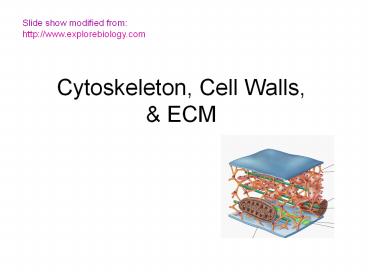Cytoskeleton, Cell Walls, - PowerPoint PPT Presentation
Title:
Cytoskeleton, Cell Walls,
Description:
Slide show modified from: http://www.explorebiology.com Cytoskeleton, Cell Walls, & ECM Cytoskeleton network of fibers extending throughout the cytoplasm ... – PowerPoint PPT presentation
Number of Views:293
Avg rating:3.0/5.0
Title: Cytoskeleton, Cell Walls,
1
Cytoskeleton, Cell Walls, ECM
Slide show modified fromhttp//www.explorebiolog
y.com
2
Cytoskeleton network of fibers extending
throughout the cytoplasm
3
(No Transcript)
4
(No Transcript)
5
- MICROTUBULES FUNCTION
- Structural support and cell movement
- Move chromosomes during cell division
- Centrioles spindle fibers
- tracks guide motor proteins
- Motor proteins dynein myosin
- cell motility
- Cilia flagella
6
(No Transcript)
7
http//www.rpi.edu/dept/bcbp/molbiochem/MBWeb/mb2/
part1/movies/kinesin.dcr
MICROTUBULES Tracks guide motor proteins to
destination (Motor proteins dynein myosin)
ATP
SEE MOTORPROTEINS inACTION
- EXAMPLES
- Vesicles containing neurotransmitters migrate to
tips of nerve cells - Vesicles move to Golgi along cytoskeletal tracks
- Cytoplasmic streaming
http//python.rice.edu/kolomeisky/transport.htm
8
Cilia and Flagella
- Are locomotor appendages
- Extensions of cytoskeleton
- Examples
- Many unicellular protists move with flagella
- Some plant reproductive cells have flagella
- Cilia in oviducts move egg toward uterus
- Cilia lining windpipe sweep mucous out of lungs
- Flagellum in sperm cells
- (Prokaryotic flagella dont have microtubules)
9
- Cilia and flagella share a common ultrastructure
10
FLAGELLUM (few, long) whip-like movement cell
moves in same direction as axis of flagellum
CILIUM (many, short) oar-like movement cell
moves perpendicular to axis of cilium
http//web.jjay.cuny.edu/acarpi/NSC/13-cells.htm
http//www.sk.lung.ca/content.cfm?edit_realwordhw
breathe
11
(No Transcript)
12
- MICROFILAMENTS
- STRUCTURE
- Thinnest class of fibers
- Twisted double chain of actin subunits
- 7 nm in diameter
- FUNCTION
- Crosslinks with microtubules (cell shape)
- Muscle cells Actin filaments interact with
myosin motor proteins to create muscle
contraction - Amoeboid movement
- Cytoplasmic streaming
13
MICROFILAMENTS
- Make up contractile apparatus of muscle
- Contain the motor protein myosin in addition to
actin
14
- Amoeboid movement
- Actin filaments constantly form dissolve making
cytoplasm liquid or stiff during movement
http//www.nextftp.com/jissen/ameba.gif
15
- Cytoplasmic streaming
- Speeds distribution of materials
http//www.daviddarling.info/images/cytoplasmic_st
reaming.gif
16
NUCLEAR LAMINA
17
(No Transcript)
18
(No Transcript)
19
Cell Walls of Plants
Protection Maintain shape Also found in
Prokaryotes, fungi, and some protists Composition
varies with species/cell type Basic
design Microfibrils of polysaccharide
cellulose embedded in matrix of other
polysaccharides (like steel reinforced
concrete)
20
Plant cell wall Structure PRIMARY CELL
WALL MIDDLE LAMELLA- between primary cell
walls of adjacent cells made of sticky
polysaccharides (pectins) glues cells
together SECONDARY CELL WALL built when cell
stops growing between plasma membrane and 1
cell wall
21
Unify plant into one living continum
22
(No Transcript)
23
(No Transcript)
24
- Types of intercellular junctions in animals
TIGHT JUNCTIONSMembranes of neighboring cells
and pressed together bound by proteins Forms
continuous seal to prevent leakage of
extracellular fluid across layer of
cells DESMOSOMES (anchoring junctions) Act like
rivets to fasten cells together into strong
sheets Intermediate proteins (keratin) anchor
desmosomes in cytoplasm GAP JUNCTIONS
(communicating junctions) Channels connect to
adjacent cells Special membrane proteins surround
pore Necessary for communication between cells in
heart muscle and animal embryos
25
The Cell A Living Unit Greater Than the Sum of
Its Parts
- Cells rely on the integration of structures and
organelles in order to function
26
(No Transcript)
27
(No Transcript)































